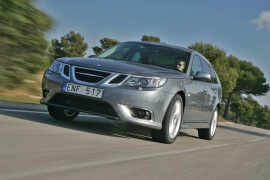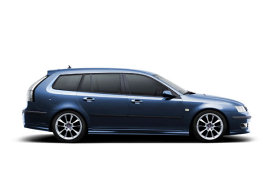SAAB 9-3 SportCombi Models/Series Timeline, Specifications & Photos
First production year: 2004
Engines: Gasoline, Ethanol, Diesel
Body style: Wagon (station wagon, estate, combi, touring)
After seven years since the model's introduction, the second generation of the 9-3 went through another facelift, imposed by the stricter Euro 5 regulations.
Built on the same platform as the Opel/Vauxhall Vectra, the Cadillac BLS, or the Chevrolet Malibu, the Saab 9-3 Sport Combi was the least expected version of the Swedish carmaker to get high selling numbers. But still, the carmaker offered it and made it somehow even more appealing than the sedan.
The facelifted version of the Sport Combi brought a fresh front fascia to the compact Swedish vehicle, inspired by the Aero-X concept car. The most significant upgrade at the front was the LED signature lamps inside the headlights, which were a first for Saab. In addition, the ascending beltline ended into the brand's specific hockey-stick design on the D-pillars. At the back, the clear lenses over the taillights flanked the tailgate, which sported a horizontal silver strip depending on the version.
Inside, the cabin featured a tall instrument cluster continued seamlessly by the center stack, tilted toward the driver. At the front, the two bucket seats were separated by a low center console. The rear passengers could enjoy a well-designed split-folding (60/40) bench that could expand the loading volume from a mere 29.7 cu-ft (841 liters) to a respectable 72.3 cu-ft (2,047 liters), measured to the roof.
Under the hood, Saab still offered engines from GM and its inventory. But, unusually, it offered also versions fit to run on bioethanol. This fuel was not very widely spread at gas stations.
Saab introduced the 9-3 model in 2002 but waited another two years to expand the range with the station wagon shape, but it did it right.
While it was supposed to share more components with the European Opel/Vauxhall Vectra, Saab heavily changed the 9-3. It didn't share any body panel with its cousin, which led to higher production costs than GM predicted.
The 9-3 featured a grille that showed a sketched plane viewed from the front, which resembled the company's heritage. Its sharp-looking headlights with corner-mounted turn signals showed the brand's determination to succeed. The SportCombi featured a unique front bumper with a lip under the apron. Depending on the version, it offered round or rectangular fog lights. At the back, Saab installed vertical, clear taillights with a narrow triangular shape. Thus, the carmaker didn't have to adapt the vehicle for the U.S. market and kept a wide-opening tailgate.
Inside, the carmaker installed a dashboard with a driver-centered design and tilted center stack. Its broad central speedometer in the instrument panel was flanked by the tachometer on the left and the fuel and temperature gauges sharing the same round dial. Saab used a different infotainment system than the rest of the GM, with optic-fiber and 300 W speakers. The bucket seats at the front were the same as those offered on the sedan, but the rear bench, with its split-folding system, was tailored for the SportCombi. It offered a huge trunk with 72.3 cu-ft (2,047 liters) of space when the seatback was folded down.
Saab offered the SportCombi with a wide choice of turbocharged gasoline or diesel engines.
SAAB 9-3 SportCombi 1.8L 5AT FWD (150 HP)
SAAB 9-3 SportCombi 1.8L 5MT FWD (122 HP)
SAAB 9-3 SportCombi 1.8L 5MT FWD (150 HP)
SAAB 9-3 SportCombi 2.0L 5AT FWD (175 HP)
SAAB 9-3 SportCombi 2.0L 5MT FWD (175 HP)
SAAB 9-3 SportCombi 2.0L 6MT FWD (175 HP)
SAAB 9-3 SportCombi 2.0L TS 5AT FWD (210 HP)
SAAB 9-3 SportCombi 2.0L TS 5MT FWD (210 HP)
SAAB 9-3 SportCombi 2.0L TS 6MT FWD (210 HP)

